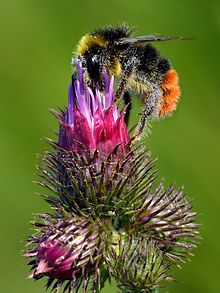Bombus lapidarius
| Red-tailed bumblebee | |
|---|---|
 |
|
| Queen | |
 |
|
| Male | |
| Scientific classification | |
| Kingdom: | Animalia |
| Phylum: | Arthropoda |
| Class: | Insecta |
| Order: | Hymenoptera |
| Family: | Apidae |
| Genus: | Bombus |
| Subgenus: | Melanobombus |
| Species: | B. lapidarius |
| Binomial name | |
|
Bombus lapidarius (Linnaeus, 1758) |
|
Bombus lapidarius is a species of bumblebee in the subgenus Melanobombus. Commonly known as the red-tailed bumblebee, B. lapidarius can be found throughout much of Central Europe. Known for its distinctive black and red body, this social bee is important in pollination.
The red-tailed bumblebee is a part of the Hymenoptera order, Apidae family, and the Bombus genus, which includes many species including Bombus genalis, Bombus angustus, and Bombus nobilis.
The red-tailed bumblebee is typically distinguished by its black body with red markings around the abdomen. Worker females and the queen look similar, except the queen is much larger than the worker females. Males typically have both the red and black coloration along with a yellow band around the abdomen and yellow markings on the face. Further, B. lapidarius tend to have a medium-sized proboscis, which is significant in that it allows the species to be a good pollinator. These bees do not typically form extensive or complex colonies. Nests usually only contain a few hundred bees, at most. An average colony consists of about 100 to 200 worker bees.
Bombus lapidarius is often found throughout Europe, including England as well as parts of Germany, Sweden, Ireland and Finland. This species typically has a fairly wide distribution. As described in the foraging patterns section, they can fly over 1500 meters to better forage for food. They typically are found in temperate regions. Further, colonies are often found in open terrain.
B. lapidarius nests have been found in many different habitats, but the bees typically prefer open terrain as opposed to more heavily forested landscapes.
Red-tailed bumblebees typically appear in the summer months of June, July, and August. Colonies are initiated via the queen, where workers and males follow roles to keep the colony thriving. Though there is a hierarchy between the queen and the rest of the colony, there does not appear to be a hierarchy between the workers themselves.
...
Wikipedia
